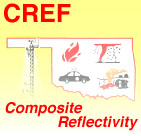|
DESCRIPTION: Composite Reflectivity is the maximum
base reflectivity value that occurs in a
given vertical column in the radar umbrella. NEXRAD scans in
several pre-defined "volume coverage patterns (VCPs), where
the radar makes a 360-degree horizontal sweep with the radar
antenna tilted at a given angle above the horizontal, then
changes the elevation angle, and completes another
360-degree sweep, and so on. Composite reflectivity gives a
plan view of the most intense portions of thunderstorms, and
can be compared with Base Reflectivity
to help determine the 3-D structure of a thunderstorm.
GENERAL INTERPRETATION:
 Schematic of Composite Reflectivity Schematic of Composite Reflectivity
 Composite Reflectivity vs. Base Reflectivity Composite Reflectivity vs. Base Reflectivity
 Cell-based VIL vs Grid-based VIL
Cell-based VIL vs Grid-based VIL
USING COMPOSITE REFLECTIVITY IN SEVERE WEATHER:
 Composite Reflectivity and Hail Composite Reflectivity and Hail
 Mesocyclone Algorithm Mesocyclone Algorithm
 Tornado Detection Algorithm Tornado Detection Algorithm
| 